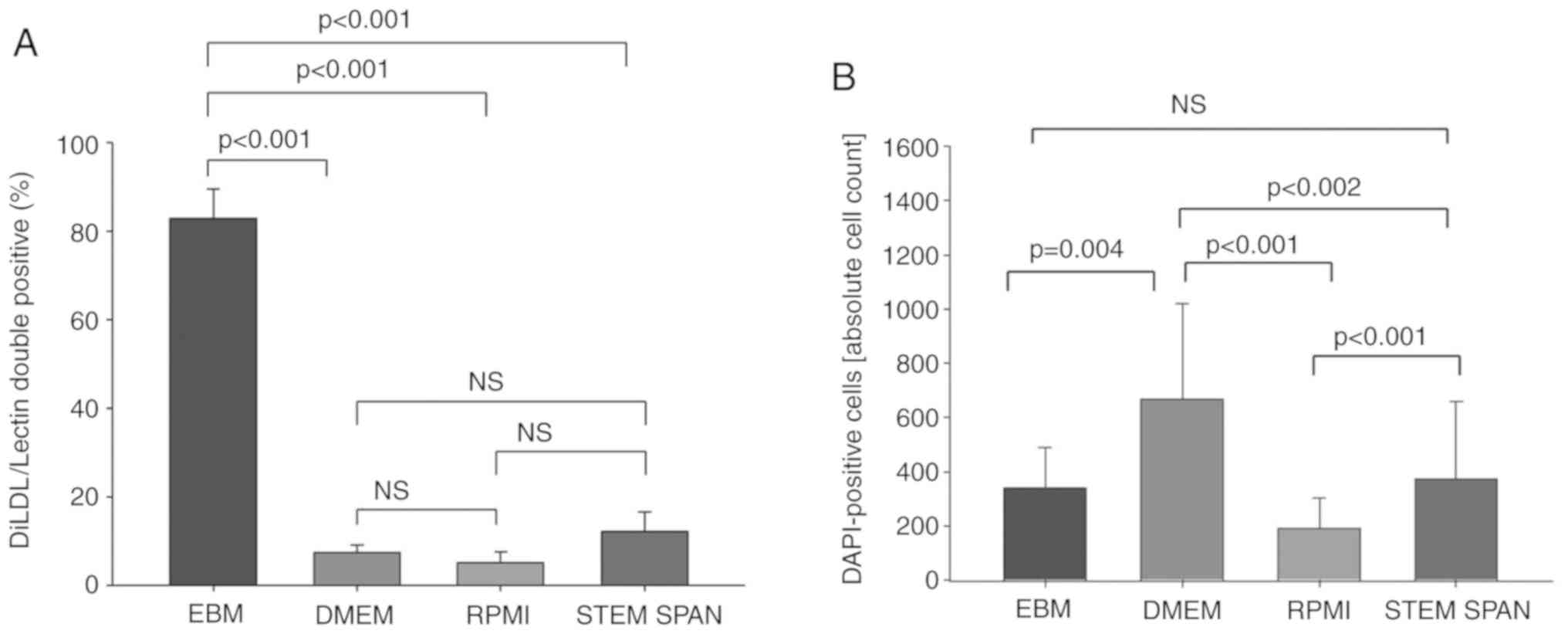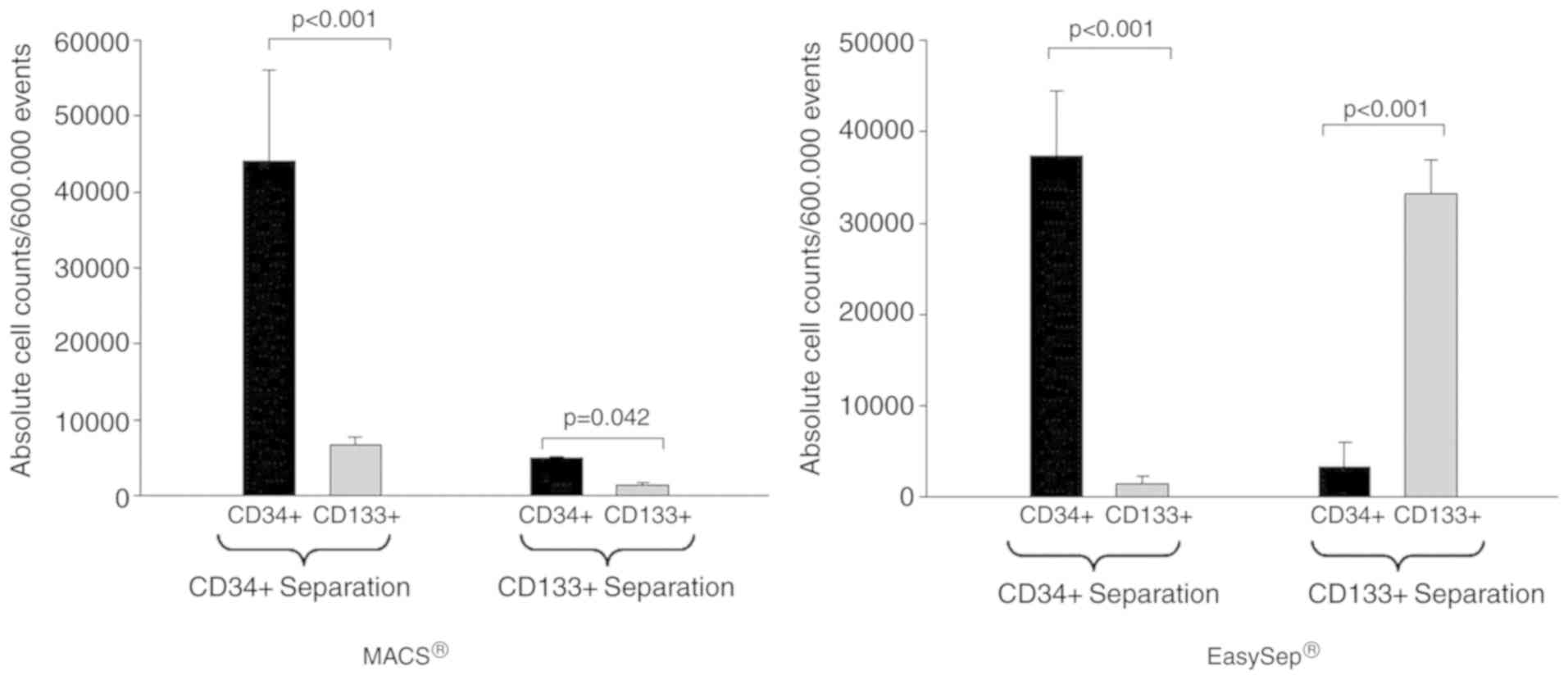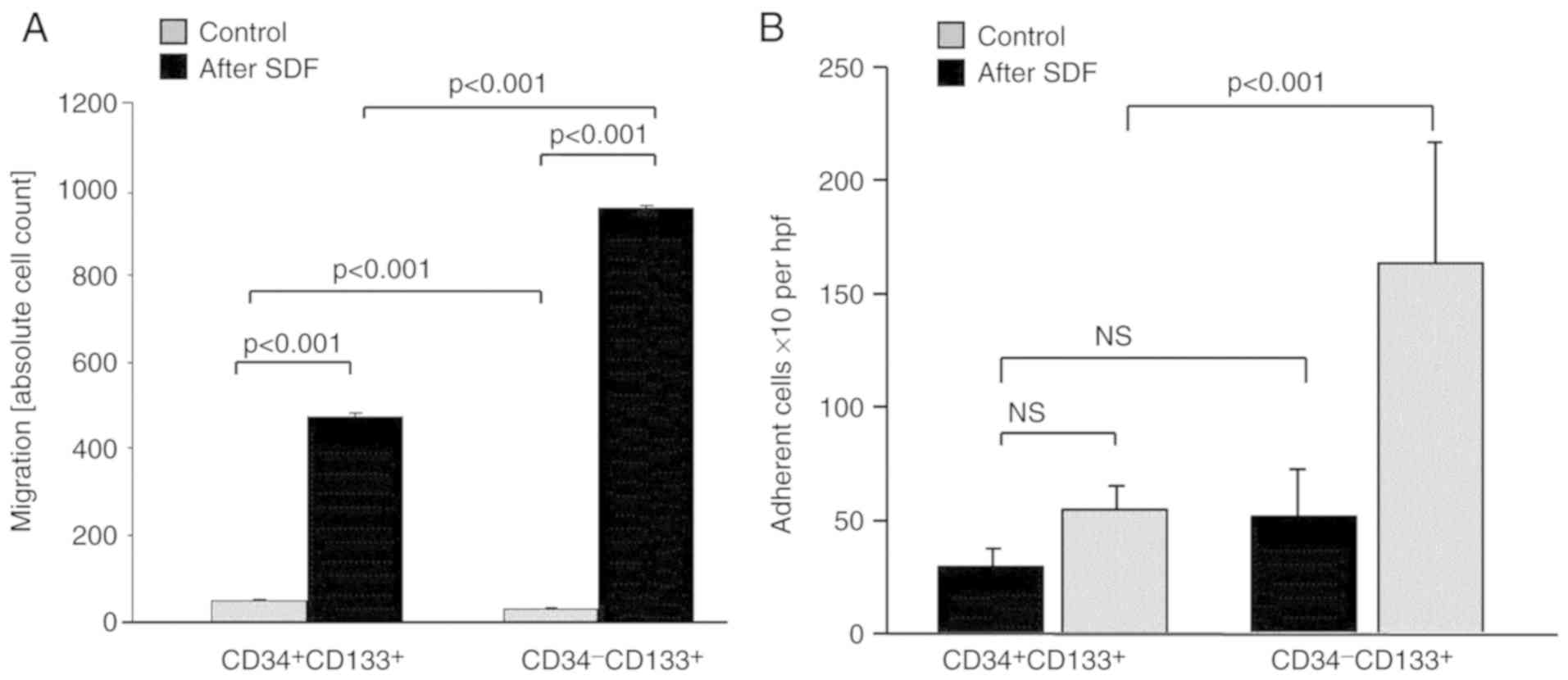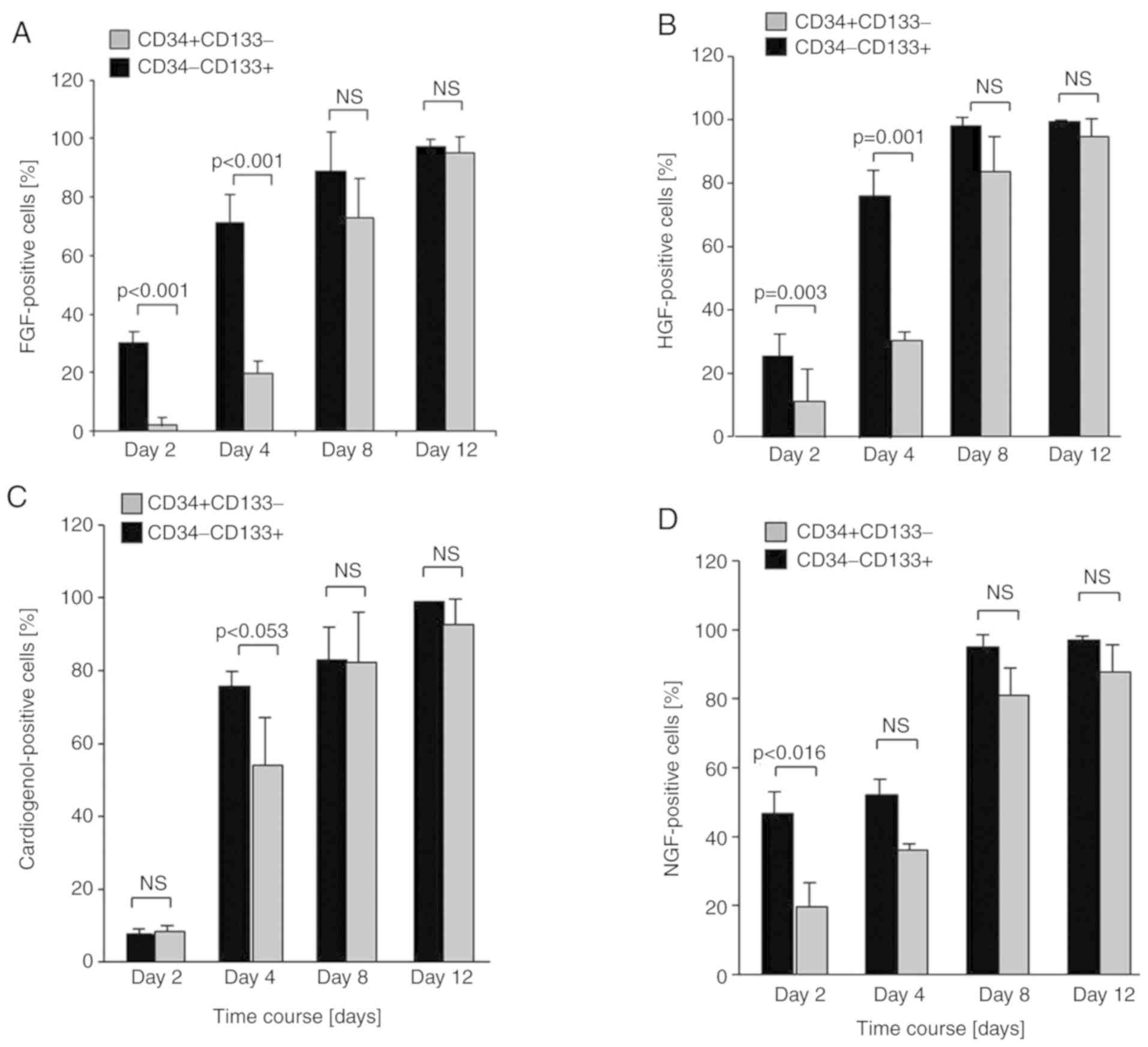|
1
|
Chopra H, Hung MK, Kwong DL, Zhang CF and
Pow EHN: Insights into endothelial progenitor cells: Origin,
classification, potentials, and prospects. Stem Cells Int.
2018:98470152018. View Article : Google Scholar : PubMed/NCBI
|
|
2
|
Salybekov AA, Kawaguchi AT, Masuda H,
Vorateera K, Okada C and Asahara T: Regeneration-associated cells
improve recovery from myocardial infarction through enhanced
vasculogenesis, anti-inflammation, and cardiomyogenesis. PLoS One.
13:e02032442018. View Article : Google Scholar : PubMed/NCBI
|
|
3
|
Mudyanadzo TA: Endothelial progenitor
cells and cardiovascular correlates. Cureus.
10:e33422018.PubMed/NCBI
|
|
4
|
Silvestre JS, Mallat Z, Tedgui A and Lévy
BI: Post-ischaemic neovascularization and inflammation. Cardiovasc
Res. 78:242–249. 2008. View Article : Google Scholar : PubMed/NCBI
|
|
5
|
Jones DA, Weeraman D, Colicchia M, Hussain
MA, Veerapen D, Andiapen M, Rathod KS, Baumbach A and Mathur A:
Impact of cell therapy on cardiovascular outcomes in patients with
refractory angina. Circ Res. 124:1786–1795. 2019. View Article : Google Scholar : PubMed/NCBI
|
|
6
|
Friedrich EB, Walenta K, Scharlau J,
Nickenig G and Werner N: CD34-/CD133+/VEGFR-2+ endothelial
progenitor cell subpopulation with potent vasoregenerative
capacities. Circ Res. 98:e20–e25. 2006. View Article : Google Scholar : PubMed/NCBI
|
|
7
|
Hristov M, Zernecke A, Liehn EA and Weber
C: Regulation of endothelial progenitor cell homing after arterial
injury. Thromb Haemost. 98:274–277. 2007. View Article : Google Scholar : PubMed/NCBI
|
|
8
|
Urbich C and Dimmeler S: Endothelial
progenitor cells: Characterization and role in vascular biology.
Circ Res. 95:343–353. 2004. View Article : Google Scholar : PubMed/NCBI
|
|
9
|
Walenta K, Friedrich EB, Sehnert F, Werner
N and Nickenig G: In vitro differentiation characteristics of
cultured human mononuclear cells-implications for endothelial
progenitor cell biology. Biochem Biophys Res Commun. 333:476–482.
2005. View Article : Google Scholar : PubMed/NCBI
|
|
10
|
Steinhoff G, Nesteruk J, Wolfien M, Kundt
G; PERFECT Trial Investigators Group, ; Börgermann J, David R,
Garbade J, Große J, Haverich A, et al: Cardiac function improvement
and bone marrow response -: Outcome analysis of the randomized
PERFECT phase III clinical trial of intramyocardial CD133+
application after myocardial infarction. EBioMedicine. 22:208–224.
2017. View Article : Google Scholar : PubMed/NCBI
|
|
11
|
Correa A, Ottoboni GS, Senegaglia AC,
Capriglione LGA, Miyague NI, Leite LMB, Jamur VR, Rebelatto CLK,
Olandoski M and Brofman PRS: Expanded CD133+ cells from human
umbilical cord blood improved heart function in rats after severe
myocardial infarction. Stem Cells Int. 2018:54124782018. View Article : Google Scholar : PubMed/NCBI
|
|
12
|
Werner N and Nickenig G: Clinical and
therapeutical implications of EPC biology in atherosclerosis. J
Cell Mol Med. 10:318–332. 2006. View Article : Google Scholar : PubMed/NCBI
|
|
13
|
Walenta KL, Bettink S, Böhm M and
Friedrich EB: Differential chemokine receptor expression regulates
functional specialization of endothelial progenitor cell
subpopulations. Basic Res Cardiol. 106:299–305. 2011. View Article : Google Scholar : PubMed/NCBI
|
|
14
|
Kaiser R, Friedrich D, Chavakis E, Böhm M
and Friedrich EB: Effect of hypoxia on integrin-mediated adhesion
of endothelial progenitor cells. J Cell Mol Med. 16:2387–2393.
2012. View Article : Google Scholar : PubMed/NCBI
|
|
15
|
Jung C, Fischer N, Fritzenwanger M, Thude
H, Ferrari M, Fabris M, Brehm BR, Barz D and Figulla HR:
Endothelial progenitor cells in adolescents: Impact of overweight,
age, smoking, sport and cytokines in younger age. Clin Res Cardiol.
98:179–188. 2009. View Article : Google Scholar : PubMed/NCBI
|
|
16
|
Lagasse E, Connors H, Al-Dhalimy M,
Reitsma M, Dohse M, Osborne L, Wang X, Finegold M, Weissman IL and
Grompe M: Purified hematopoietic stem cells can differentiate into
hepatocytes in vivo. Nat Med. 6:1229–1234. 2000. View Article : Google Scholar : PubMed/NCBI
|
|
17
|
Brazelton TR, Rossi FM, Keshet GI and Blau
HM: From marrow to brain: Expression of neuronal phenotypes in
adult mice. Science. 290:1775–1779. 2000. View Article : Google Scholar : PubMed/NCBI
|
|
18
|
Orlic D, Kajstura J, Chimenti S, Jakoniuk
I, Anderson SM, Li B, Pickel J, McKay R, Nadal-Ginard B, Bodine DM,
et al: Bone marrow cells regenerate infarcted myocardium. Nature.
410:701–705. 2001. View Article : Google Scholar : PubMed/NCBI
|
|
19
|
Müller P, Pfeiffer P, Koglin J, Schäfers
HJ, Seeland U, Janzen I, Urbschat S and Böhm M: Cardiomyocytes of
noncardiac origin in myocardial biopsies of human transplanted
hearts. Circulation. 106:31–35. 2002. View Article : Google Scholar : PubMed/NCBI
|
|
20
|
Deb A, Wang S, Skelding KA, Miller D,
Simper D and Caplice NM: Bone marrow-derived c.ardiomyocytes are
present in adult human heart: A study of gender-mismatched bone
marrow transplantation patients. Circulation. 107:1247–1249. 2003.
View Article : Google Scholar : PubMed/NCBI
|
|
21
|
Badorff C, Brandes RP, Popp R, Rupp S,
Urbich C, Aicher A, Fleming I, Busse R, Zeiher AM and Dimmeler S:
Transdifferentiation of blood-derived human adult endothelial
progenitor cells into functionally active cardiomyocytes.
Circulation. 107:1024–1032. 2003. View Article : Google Scholar : PubMed/NCBI
|
|
22
|
Koyanagi M, Urbich C, Chavakis E, Hoffmann
J, Rupp S, Badorff C, Zeiher AM, Starzinski-Powitz A, Haendeler J
and Dimmeler S: Differentiation of circulating endothelial
progenitor cells to a cardiomyogenic phenotype depends on
E-cadherin. FEBS Lett. 579:6060–6066. 2005. View Article : Google Scholar : PubMed/NCBI
|
|
23
|
Friedrich EB, Werner C, Walenta K, Böhm M
and Scheller B: Role of extracellular signal-regulated kinase for
endothelial progenitor cell dysfunction in coronary artery disease.
Basic Res Cardiol. 104:613–620. 2009. View Article : Google Scholar : PubMed/NCBI
|
|
24
|
Werner C, Böhm M and Friedrich EB: Role of
integrin-linked kinase for functional capacity of endothelial
progenitor cells in patients with stable coronary artery disease.
Biochem Biophys Res Commun. 377:331–336. 2008. View Article : Google Scholar : PubMed/NCBI
|
|
25
|
Friedrich EB, Tager AM, Liu E, Pettersson
A, Owman C, Munn L, Luster AD and Gerszten RE: Mechanisms of
leukotriene B4-triggered monocyte adhesion. Arterioscler Thromb
Vasc Biol. 23:1761–1767. 2003. View Article : Google Scholar : PubMed/NCBI
|
|
26
|
Ge Q, Zhang H, Hou J, Wan L, Cheng W, Wang
X, Dong D, Chen C, Xia J, Guo J, et al: VEGF secreted by
mesenchymal stem cells mediates the differentiation of endothelial
progenitor cells into endothelial cells via paracrine mechanisms.
Mol Med Rep. 17:1667–1675. 2018.PubMed/NCBI
|
|
27
|
Rossi E, Smadja D, Goyard C, Cras A,
Dizier B, Bacha N, Lokajczyk A, Guerin CL, Gendron N, Planquette B,
et al: Co-injection of mesenchymal stem cells with endothelial
progenitor cells accelerates muscle recovery in hind limb ischemia
through an endoglin-dependent mechanism. Thromb Haemost.
117:1908–1918. 2017. View Article : Google Scholar : PubMed/NCBI
|
|
28
|
Rossi E, Smadja DM, Boscolo E, Langa C,
Arevalo MA, Pericacho M, Gamella-Pozuelo L, Kauskot A, Botella LM,
Gaussem P, et al: Endoglin regulates mural cell adhesion in the
circulatory system. Cell Mol Life Sci. 73:1715–1739. 2016.
View Article : Google Scholar : PubMed/NCBI
|
|
29
|
Koutna I, Peterkova M, Simara P, Stejskal
S, Tesarova L and Kozubek M: Proliferation and differentiation
potential of CD133+ and CD34+ populations from the bone marrow and
mobilized peripheral blood. Ann Hematol. 90:127–137. 2011.
View Article : Google Scholar : PubMed/NCBI
|
|
30
|
Fritzenwanger M, Lorenz F, Jung C, Fabris
M, Thude H, Barz D and Figulla HR: Differential number of CD34+,
CD133+ and CD34+/CD133+ cells in peripheral blood of patients with
congestive heart failure. Eur J Med Res. 14:113–117.
2009.PubMed/NCBI
|
|
31
|
Yao W, Firth AL, Sacks RS, Ogawa A, Auger
WR, Fedullo PF, Madani MM, Lin GY, Sakakibara N, Thistlethwaite PA,
et al: Identification of putative endothelial progenitor cells
(CD34+CD133+Flk-1+) in endarterectomized tissue of patients with
chronic thromboembolic pulmonary hypertension. Am J Physiol Lung
Cell Mol Physiol. 296:L870–L878. 2009. View Article : Google Scholar : PubMed/NCBI
|
|
32
|
Otto S, Nitsche K, Jung C, Kryvanos A,
Zhylka A, Heitkamp K, Gutiérrez-Chico JL, Goebel B, Schulze PC,
Figulla HR and Poerner TC: Endothelial progenitor cells and plaque
burden in stented coronary artery segments: An optical coherence
tomography study six months after elective PCI. BMC Cardiovasc
Disord. 17:1032017. View Article : Google Scholar : PubMed/NCBI
|
|
33
|
Golab-Janowska M, Paczkowska E,
Machalinski B, Kotlega D, Meller A, Safranow K, Wankowicz P and
Nowacki P: Elevated inflammatory parameter levels negatively impact
populations of circulating stem cells (CD133+), early endothelial
progenitor cells (CD133+/VEGFR2+), and fibroblast growth factor in
stroke patients. Curr Neurovasc Res. 16:19–26. 2019. View Article : Google Scholar : PubMed/NCBI
|
|
34
|
Skrzypkowska M, Słomiński B,
Ryba-Stanisławowska M, Gutknecht P and Siebert J: Circulating CD34+
and CD34+VEGFR2+ progenitor cells are associated with KLOTHO KL-VS
polymorphism. Microvasc Res. 119:1–6. 2018. View Article : Google Scholar : PubMed/NCBI
|
|
35
|
Kleinbongard P and Weber AA: Impaired
interaction between platelets and endothelial progenitor cells in
diabetic patients. Basic Res Cardiol. 103:569–571. 2008. View Article : Google Scholar : PubMed/NCBI
|


















